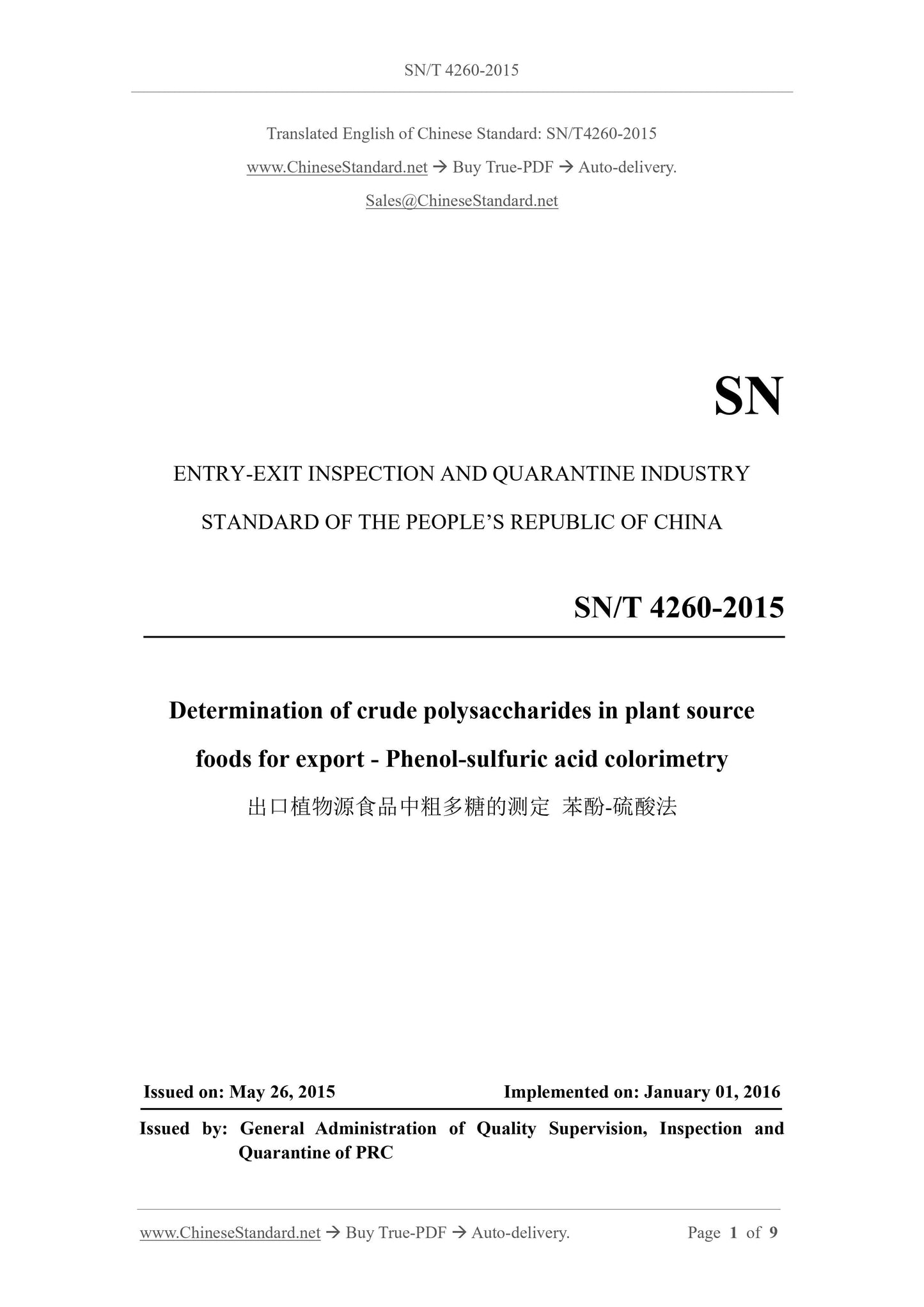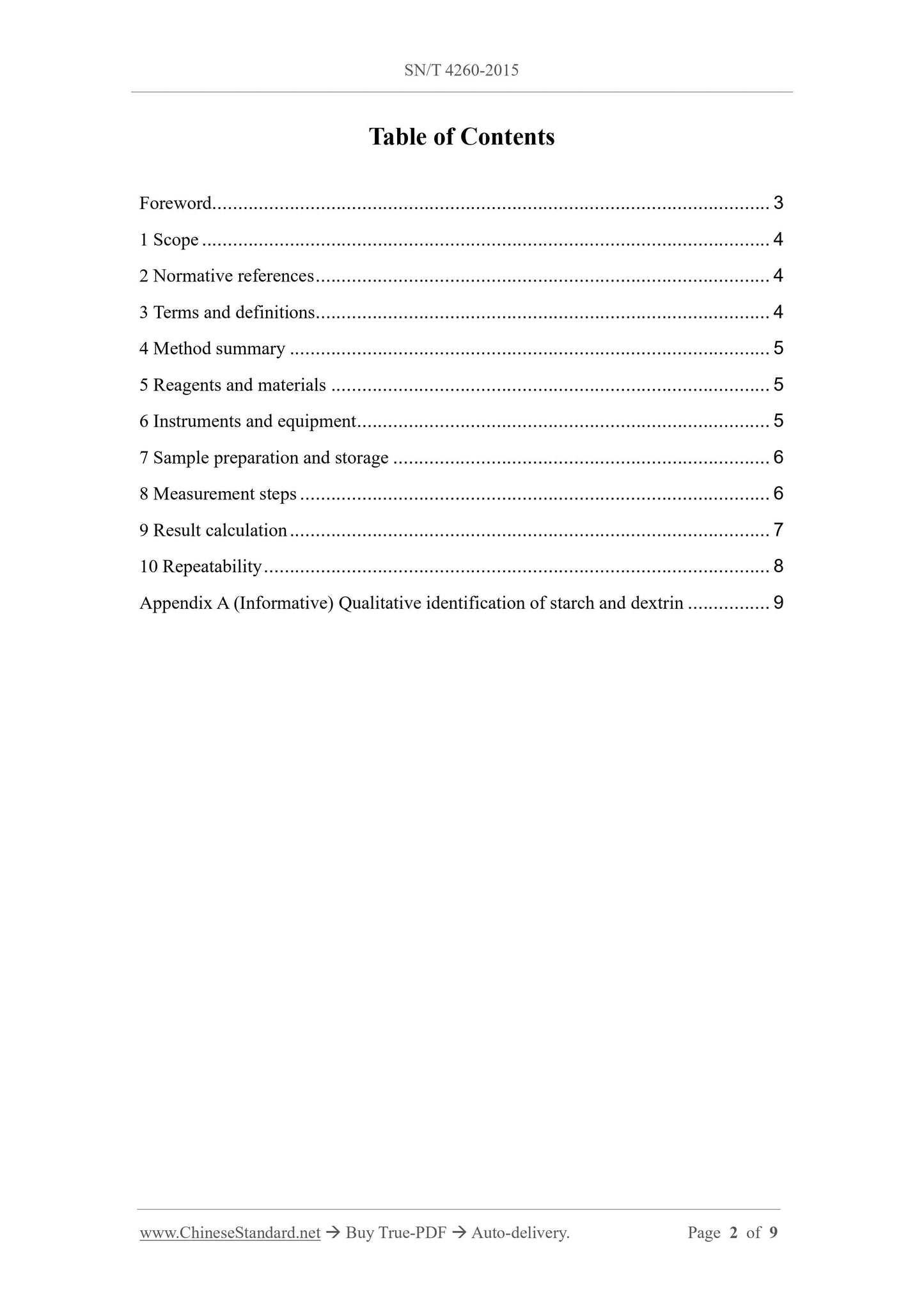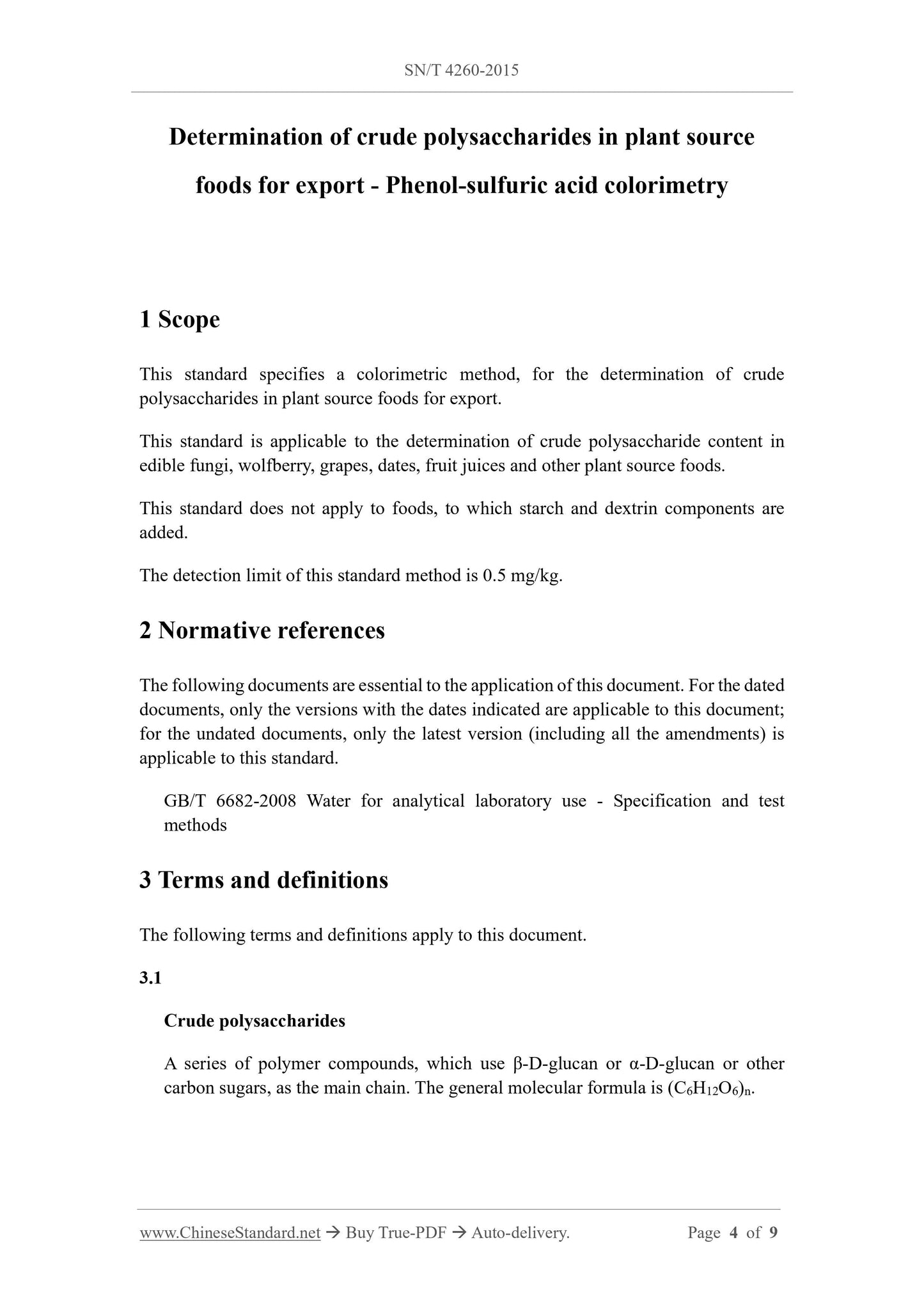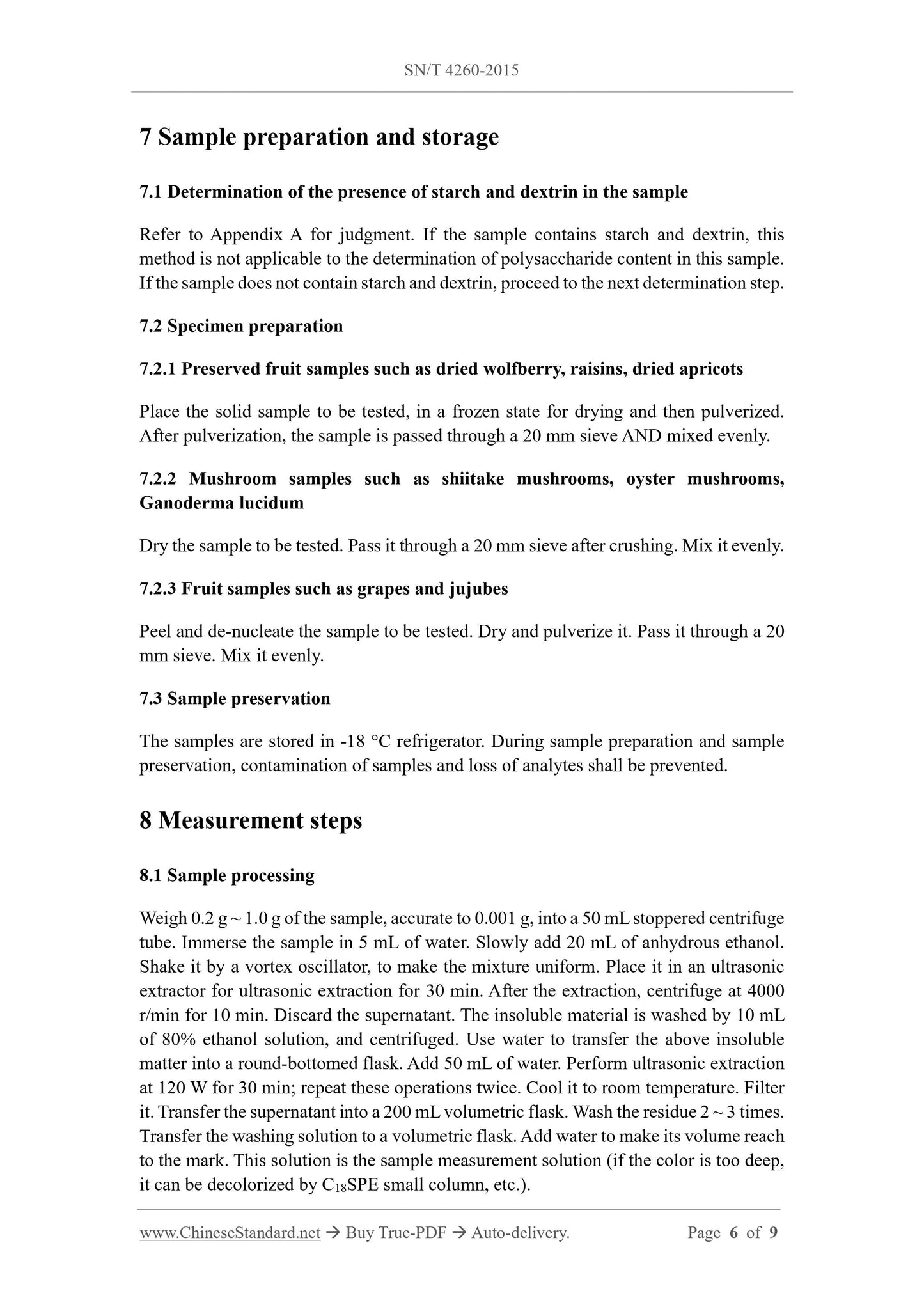1
/
van
4
PayPal, credit cards. Download editable-PDF & invoice in 1 second!
SN/T 4260-2015 English PDF (SNT4260-2015)
SN/T 4260-2015 English PDF (SNT4260-2015)
Normale prijs
$125.00 USD
Normale prijs
Aanbiedingsprijs
$125.00 USD
Eenheidsprijs
/
per
Verzendkosten worden berekend bij de checkout.
Kan beschikbaarheid voor afhalen niet laden
Delivery: 3 seconds. Download true-PDF + Invoice.
Get QUOTATION in 1-minute: Click SN/T 4260-2015
Historical versions: SN/T 4260-2015
Preview True-PDF (Reload/Scroll if blank)
SN/T 4260-2015: Determination of crude polysaccharides in plant source foods for export. Phehol-sulfuric acid colorimetry
SN/T 4260-2015
ENTRY-EXIT INSPECTION AND QUARANTINE INDUSTRY
STANDARD OF THE PEOPLE’S REPUBLIC OF CHINA
Determination of crude polysaccharides in plant source
foods for export - Phenol-sulfuric acid colorimetry
ISSUED ON: MAY 26, 2015
IMPLEMENTED ON: JANUARY 01, 2016
Issued by: General Administration of Quality Supervision, Inspection and
Quarantine of PRC
Table of Contents
Foreword ... 3
1 Scope ... 4
2 Normative references ... 4
3 Terms and definitions... 4
4 Method summary ... 5
5 Reagents and materials ... 5
6 Instruments and equipment ... 5
7 Sample preparation and storage ... 6
8 Measurement steps ... 6
9 Result calculation ... 7
10 Repeatability ... 8
Appendix A (Informative) Qualitative identification of starch and dextrin ... 9
Determination of crude polysaccharides in plant source
foods for export - Phenol-sulfuric acid colorimetry
1 Scope
This standard specifies a colorimetric method, for the determination of crude
polysaccharides in plant source foods for export.
This standard is applicable to the determination of crude polysaccharide content in
edible fungi, wolfberry, grapes, dates, fruit juices and other plant source foods.
This standard does not apply to foods, to which starch and dextrin components are
added.
The detection limit of this standard method is 0.5 mg/kg.
2 Normative references
The following documents are essential to the application of this document. For the dated
documents, only the versions with the dates indicated are applicable to this document;
for the undated documents, only the latest version (including all the amendments) is
applicable to this standard.
GB/T 6682-2008 Water for analytical laboratory use - Specification and test
methods
3 Terms and definitions
The following terms and definitions apply to this document.
3.1
Crude polysaccharides
A series of polymer compounds, which use β-D-glucan or α-D-glucan or other
carbon sugars, as the main chain. The general molecular formula is (C6H12O6)n.
7 Sample preparation and storage
7.1 Determination of the presence of starch and dextrin in the sample
Refer to Appendix A for judgment. If the sample contains starch and dextrin, this
method is not applicable to the determination of polysaccharide content in this sample.
If the sample does not contain starch and dextrin, proceed to the next determination step.
7.2 Specimen preparation
7.2.1 Preserved fruit samples such as dried wolfberry, raisins, dried apricots
Place the solid sample to be tested, in a frozen state for drying and then pulverized.
After pulverization, the sample is passed through a 20 mm sieve AND mixed evenly.
7.2.2 Mushroom samples such as shiitake mushrooms, oyster mushrooms,
Ganoderma lucidum
Dry the sample to be tested. Pass it through a 20 mm sieve after crushing. Mix it evenly.
7.2.3 Fruit samples such as grapes and jujubes
Peel and de-nucleate the sample to be tested. Dry and pulverize it. Pass it through a 20
mm sieve. Mix it evenly.
7.3 Sample preservation
The samples are stored in -18 °C refrigerator. During sample preparation and sample
preservation, contamination of samples and loss of analytes shall be prevented.
8 Measurement steps
8.1 Sample processing
Weigh 0.2 g ~ 1.0 g of the sample, accurate to 0.001 g, into a 50 mL stoppered centrifuge
tube. Immerse the sample in 5 mL of water. Slowly add 20 mL of anhydrous ethanol.
Shake it by a vortex oscillator, to make the mixture uniform. Place it in an ultrasonic
extractor for ultrasonic extraction for 30 min. After the extraction, centrifuge at 4000
r/min for 10 min. Discard the supernatant. The insoluble material is washed by 10 mL
of 80% ethanol solution, and centrifuged. Use water to transfer the above insoluble
matter into a round-bottomed flask. Add 50 mL of water. Perform ultrasonic extraction
at 120 W for 30 min; repeat these operations twice. Cool it to room temperature. Filter
it. Transfer the supernatant into a 200 mL volumetric flask. Wash the residue 2 ~ 3 times.
Transfer the washing solution to a volumetric flask. Add water to make its volume reach
to the mark. This solution is the sample measurement solution (if the color is too deep,
it can be decolorized by C18SPE small column, etc.).
Get QUOTATION in 1-minute: Click SN/T 4260-2015
Historical versions: SN/T 4260-2015
Preview True-PDF (Reload/Scroll if blank)
SN/T 4260-2015: Determination of crude polysaccharides in plant source foods for export. Phehol-sulfuric acid colorimetry
SN/T 4260-2015
ENTRY-EXIT INSPECTION AND QUARANTINE INDUSTRY
STANDARD OF THE PEOPLE’S REPUBLIC OF CHINA
Determination of crude polysaccharides in plant source
foods for export - Phenol-sulfuric acid colorimetry
ISSUED ON: MAY 26, 2015
IMPLEMENTED ON: JANUARY 01, 2016
Issued by: General Administration of Quality Supervision, Inspection and
Quarantine of PRC
Table of Contents
Foreword ... 3
1 Scope ... 4
2 Normative references ... 4
3 Terms and definitions... 4
4 Method summary ... 5
5 Reagents and materials ... 5
6 Instruments and equipment ... 5
7 Sample preparation and storage ... 6
8 Measurement steps ... 6
9 Result calculation ... 7
10 Repeatability ... 8
Appendix A (Informative) Qualitative identification of starch and dextrin ... 9
Determination of crude polysaccharides in plant source
foods for export - Phenol-sulfuric acid colorimetry
1 Scope
This standard specifies a colorimetric method, for the determination of crude
polysaccharides in plant source foods for export.
This standard is applicable to the determination of crude polysaccharide content in
edible fungi, wolfberry, grapes, dates, fruit juices and other plant source foods.
This standard does not apply to foods, to which starch and dextrin components are
added.
The detection limit of this standard method is 0.5 mg/kg.
2 Normative references
The following documents are essential to the application of this document. For the dated
documents, only the versions with the dates indicated are applicable to this document;
for the undated documents, only the latest version (including all the amendments) is
applicable to this standard.
GB/T 6682-2008 Water for analytical laboratory use - Specification and test
methods
3 Terms and definitions
The following terms and definitions apply to this document.
3.1
Crude polysaccharides
A series of polymer compounds, which use β-D-glucan or α-D-glucan or other
carbon sugars, as the main chain. The general molecular formula is (C6H12O6)n.
7 Sample preparation and storage
7.1 Determination of the presence of starch and dextrin in the sample
Refer to Appendix A for judgment. If the sample contains starch and dextrin, this
method is not applicable to the determination of polysaccharide content in this sample.
If the sample does not contain starch and dextrin, proceed to the next determination step.
7.2 Specimen preparation
7.2.1 Preserved fruit samples such as dried wolfberry, raisins, dried apricots
Place the solid sample to be tested, in a frozen state for drying and then pulverized.
After pulverization, the sample is passed through a 20 mm sieve AND mixed evenly.
7.2.2 Mushroom samples such as shiitake mushrooms, oyster mushrooms,
Ganoderma lucidum
Dry the sample to be tested. Pass it through a 20 mm sieve after crushing. Mix it evenly.
7.2.3 Fruit samples such as grapes and jujubes
Peel and de-nucleate the sample to be tested. Dry and pulverize it. Pass it through a 20
mm sieve. Mix it evenly.
7.3 Sample preservation
The samples are stored in -18 °C refrigerator. During sample preparation and sample
preservation, contamination of samples and loss of analytes shall be prevented.
8 Measurement steps
8.1 Sample processing
Weigh 0.2 g ~ 1.0 g of the sample, accurate to 0.001 g, into a 50 mL stoppered centrifuge
tube. Immerse the sample in 5 mL of water. Slowly add 20 mL of anhydrous ethanol.
Shake it by a vortex oscillator, to make the mixture uniform. Place it in an ultrasonic
extractor for ultrasonic extraction for 30 min. After the extraction, centrifuge at 4000
r/min for 10 min. Discard the supernatant. The insoluble material is washed by 10 mL
of 80% ethanol solution, and centrifuged. Use water to transfer the above insoluble
matter into a round-bottomed flask. Add 50 mL of water. Perform ultrasonic extraction
at 120 W for 30 min; repeat these operations twice. Cool it to room temperature. Filter
it. Transfer the supernatant into a 200 mL volumetric flask. Wash the residue 2 ~ 3 times.
Transfer the washing solution to a volumetric flask. Add water to make its volume reach
to the mark. This solution is the sample measurement solution (if the color is too deep,
it can be decolorized by C18SPE small column, etc.).
Share








